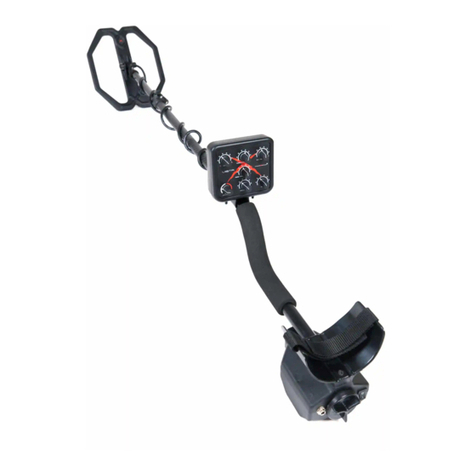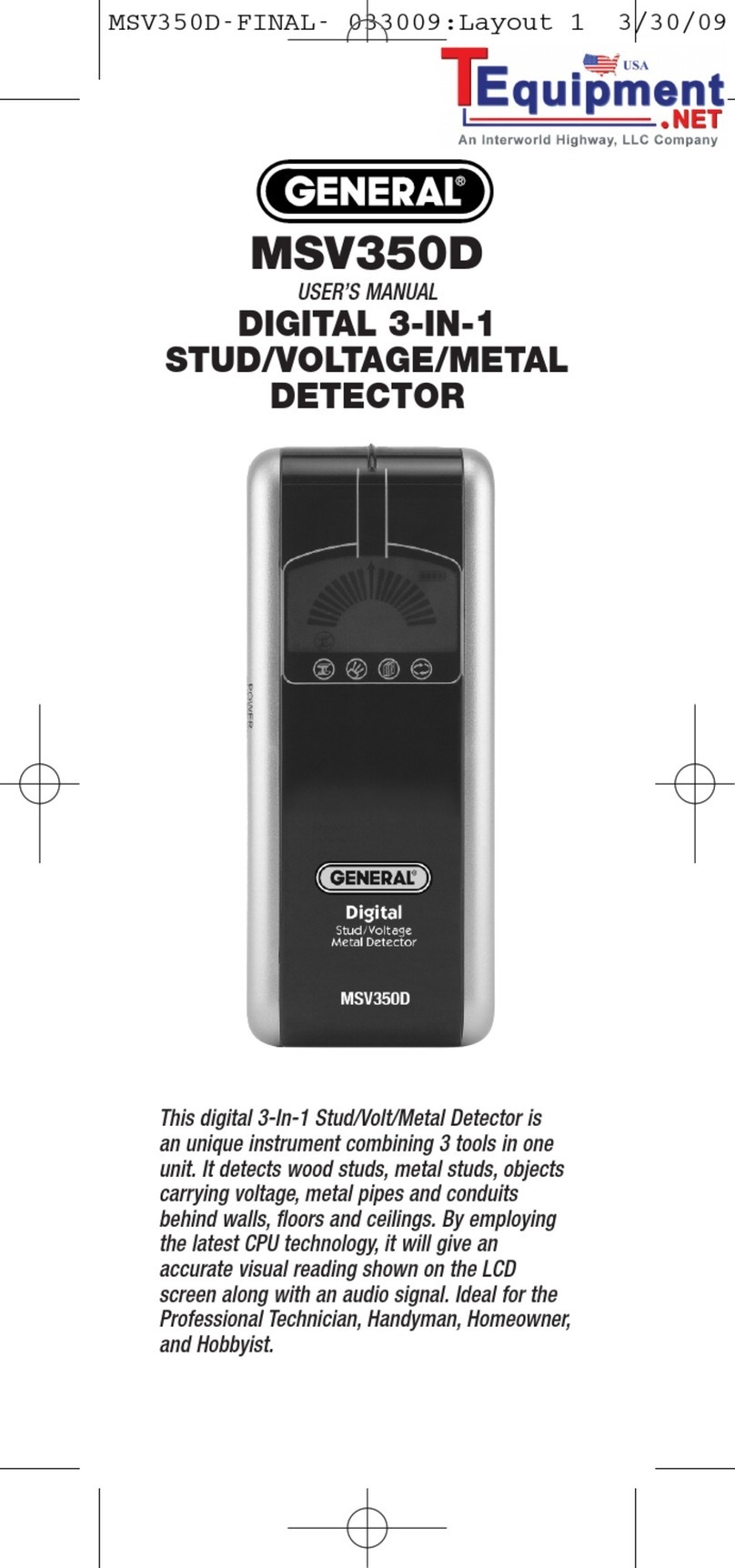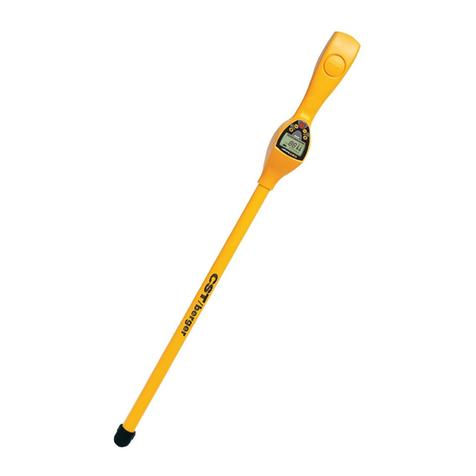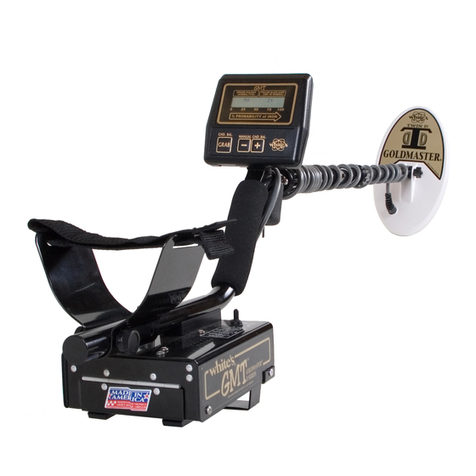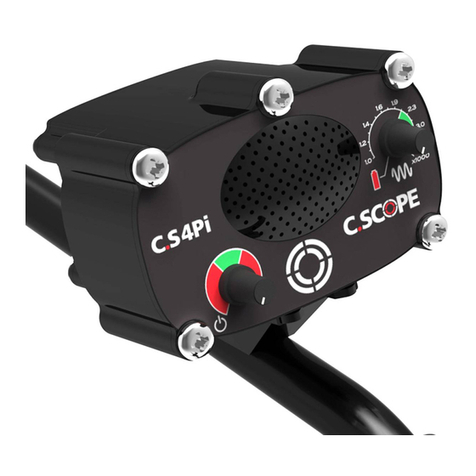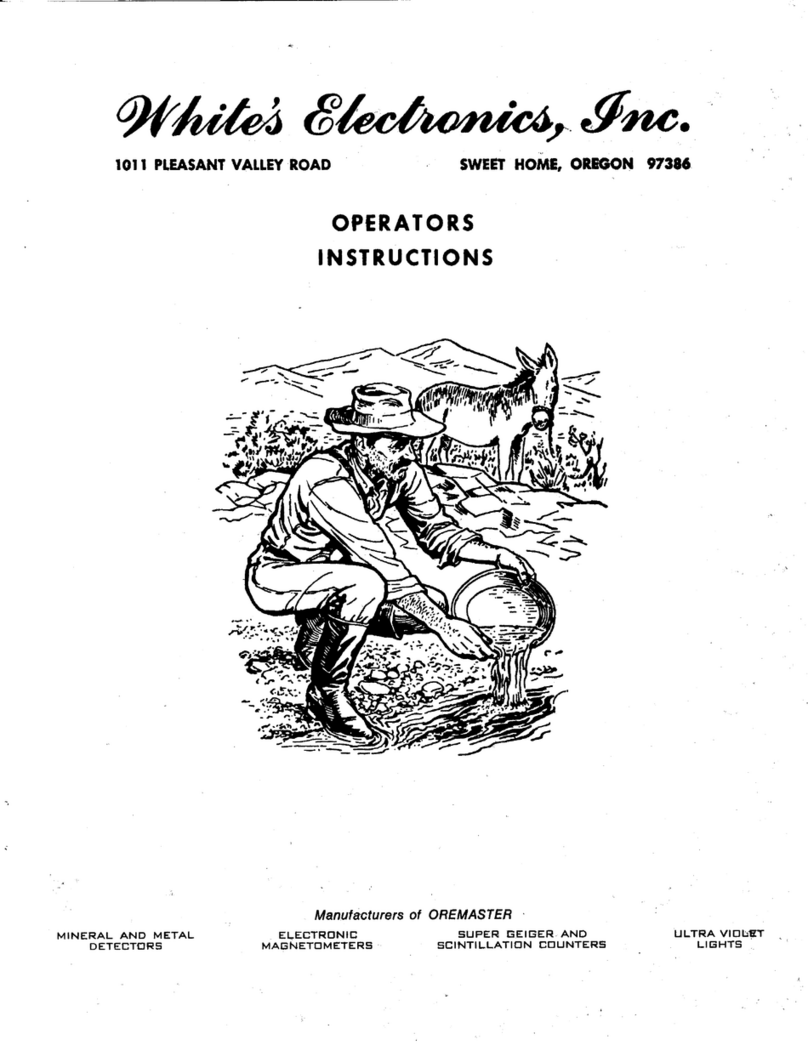Laser Rapier II Assembly instructions

MOST IMPORTANT- WHEN RETURNING UNIT FOR SERVICE
1. All units returned under warranty must be accompanied by copy of
original dated invoice. Failure to do this will incure repair charges.
2. Please include full details of the fault.
3. Include payment of £8 for return carriage.
4. Send unit to: SERVICE DEPARTMENT: Pentechnic, 1 Grange
Cottages, Penkridge, Staffs ST19 5NH
LIMITED ON (1) YEAR WARRANTY (UK)
This warranty gives you specific legal rights, and you may also have other rights.
TESORO/LASER assures you of the finest electronic equipment and service.
TESORO/LASER warrants that each detector manufactured by it will be free from
defects in materials and workmanship for a period of one (1) year. Should any fail-
ure to conform to the foregoing warranty appear within this period,
TESORO/LASER will, at its option, repair or replace the defective detector with-
out any charge except any transportation charges. This warranty does not cover
any detector that has been abused, tampered with, or repaired by an unautho-
rized party. This warranty applies only to units purchased from AUTHORIZED
UK DEALERS. This warranty excludes batteries, damage caused by leaking bat-
teries, cable faults due to flexing on body mount units, and wear of the search coil
housing. Complete, detach and mail the portion below within 10 days of purchase
in order to activate your warranty. Send the WARRANTY to : TREASURE
WORLD, 192 Albany st. LONDON NW1 4AP.
≫Cut along this line
MODEL SERIAL No.
DATE
PURCHASER’S NAME
ADDRESS
Where did you first learn of TESORO/LASER products?
What made you decide to buy TESORO/LASER?
Purchased where?
What do you like or dislike about the product?
LASER METAL DETECTORS
192 Albany Street
London, NW1 4AP
Telephone 207-387-3142
━━━━━━━━━━━━━━━━━━━━━━━━━━━━━━━━━
OPERATOR INSTRUCTION MANUAL

What does the factory include with my detector?
See UNPACKING THE BOX on page 6.
How do I put my detector together?
See ASSEMBLING YOUR DETECTOR on pages 8-9.
How do I install a new battery?
See INSTALLING THE BATTERY on page 7.
Is my battery working and when should I change it?
See Performing the Audio Battery test on page 16.
How does my detector work?
See GENERAL DESCRIPTION on page 5.
What features does my detector have?
See Rapier FEATURES on page 24.
What are Discriminate Mode and Pinpoint Mode?
See Selecting the Proper Operating Mode on page 14.
How do I select one of the operating modes?
See Selecting the Proper Operating Mode on page 14.
How do I adjust the discrimination feature?
See DISC LEVEL Control on page 12.
How much discrimination should I use?
See Setting the Discrimination Level on page 15.
How do I adjust the sensitivity feature?
See SENSITIVITY CONTROL on page 11.
How much sensitivity should I use?
See Setting the Sensitivity Level on page 14.
When do I use the MAXBoost feature?
See Setting the Sensitivity Level in MAXBoost on page 15.
Can I adjust the speaker volume?
See Controlling Audio Volume on page 13.
How do I hold and move my detector when using it?
See Handling you detector on page 17.
How do I find the exact location of a metal object?
See Pinpointing a target on page 19.
How do I dig up a buried metal object?
See Recovering a target on Pages 19-21.
What can I do to get better at using my detector?
See Basic Care and Protecting you Investment on pages 22-23.
What is my warranty and where can I get service?
See the back cover
INDEX OF COMMON QUESTIONS
25
GENERAL INFORMATION

LASER RAPIER II OPERATOR INSTRUCTION MANUAL
CONGRATULATIONS!
Thank you for purchasing the Laser Rapier II. The Rapier II was
designed for the user who requires top of the line performance com-
bined with total ease of use.
The Laser Rapier II has the power and stability to handle the
most hostile terrain. Its ability to punch through the ground should sat-
isfy the most demanding operator. Sensitivity to tiny gold, silver &
bronze coins and artifacts should result in more of this class to find.
Take the time to study this manual and familiarize yourself with your de-
tector and you can look forward to many hours of fruitful searching in
the years to come.
Good Hunting
Frank Mellish
High Gain Sensitivity Circuitry – designed specifi-
cally to deliver greater depth, sensitivity and stability.
MAXBoost Feature- extra power of super high gain can
add inches to search depth.
High-sensitivity Searchcoil- a 9x8 inch spoked,
concentric for broad sweep, good pinpointing and deep ground
penetration.
Ultra-lightweight-Search longer without fatigue.
3 piece Knockdown Pole-convenient storage and
travel
Turn-on-and-go-factory preset for “mineral free” operation.
Two Operating Modes-Pinpoint and Discriminate.
QuickCheck PINPOINT-simple push-button pinpointing.
Easy to Operate-simple controls at your fingertips.
Silent Search Operation-in Discriminate Mode.
Economical to Use-up to 20 hours plus on a single battery.
What it doesn’t have
Abig, heavy, high-powered speaker. Loud, heavy speakers are popular
with many manufacturers. The “fuller” sound they produce gives the illu-
sion of greater sensitivity to small and deep targets - a great showroom
sales tool! Most serious detectorists hunt with headphones and a Rapier
will work well with standard headphones. If you choose not to use head-
phones, the Rapier speaker will be loud enough for most environments. It
will allow you to hear the small and deep targets found by the high power
circuitry-without excessive battery drain.
A hip mount, arm strap or battery recharging system. These kinds of
“built-in accessories” are simply unnecessary in a Rapier II detector.
The power and features of the Laser Rapier II make it an ideal detector for a beginner who
wants a machine they will never outgrow. It is also ideal for the serious detectorist who wants
power, performance, simplicity, and versatility in a single lightweight detector.
24
LASER RAPIER II
OPERATOR INSTRUCTION MANUAL

LASER RAPIER II OPERATOR INSTRUCTION MANUAL
☑The searchcoil cable is hard wired to the searcoil and protected by a
strain relief. Inspect the strain relief frequently to make sure it is firmly
attached and intact.
☑Keep cables properly wound around the pole stems and protect them
during use. Floppy, pinched, or snagged cables may short, causing er-
ratic noises or unnecessary replacement of the searchcoil.
☑Sweep the searchcoil carefully, especially when using around rocks
and building foundations and avoid hitting the searchcoil against hard,
solid objects and surfaces.
☑Keep your searchcoil slightly off of the ground during the sweep es-
pecially when using in gravel or hard, rocky dirt.
☑Always use a properly designed protective scuff cover on the search-
coil.
☑Remove and clean out scuff covers periodically to avoid buildup of
mineralized dirt particles which will affect performance.
☑The searchcoil is waterproof and can be submerged in either fresh or
salt water. After the searchcoil is used in salt water, rinse it and the
lower stem assembly well with fresh water to prevent corrosion of the
metal parts.
☑The searchcoil is waterproof but the electronics are not, so always
prevent any moisture or water from entering the control housing and
never allow the cable connectors to become submerged in water.
☑If working in or near water, or if there is a possibility of rain, use a pro-
tective weather resistant pouch or plastic bag to cover the control hous-
ing. Make sure it can “breath” in order to ensure against condensation
buildup inside.
☑After each use, clean the detector with a soft cloth to remove dust,
moisture, or other contaminants.
☑When transporting the detector in a car during hot weather, store it on
the floor of the passenger compartment if possible. Using a carry bag
gives additional protection. In any case, never allow the detector to
roll around unprotected in the trunk or back of a pickup truck.
☑Protect your detector from dust, moisture, and extreme temperatures
during storage.
☑When shipping, use the original factory carton or similar heavy-duty
container, and provide a minimum one inch of padding around all
parts.
☑Treat your detector as you would any sensitive electronic instrument.
Though ruggedly constructed and designed to withstand the demands
of normal treasure hunting, proper care is essential.
INTRODUCTION ................................................ 4
GENERAL DESCRIPTION ...................................5
GETTING STARTED
UNPACKING THE BOX .......................................6
INSTALLING THE BATTERY ...............................7
ASSEMBLING YOUR DETECTOR........................8
ADJUSTING THE POLE & SEARCHCOIL..........10
OPERATING TECHNIQUES
CONTROLS .......................................................11
SENSITIVITY Control ..............................................................11
DISC LEVEL Control...............................................................12
THRESHOLD LEVEL Control.................................................12
QuickCheck PINPOINT Push-button ....................................13
Controlling Audio Volume......................................................13
TUNING YOUR DETECTOR...............................13
Selecting the proper operating mode...................................14
Setting the Sensitivity Level..................................................14
Setting the Sensitivity Level in MAX Boost .........................15
Setting the Discrimination Level...........................................15
Chart - Discrimination Level Settings ..................................15
Setting the Threshold Level ..................................................16
Performing the Audio Battery Test .......................................16
23
2
CONTENTS
GENERAL INFORMATION

LASER RAPIER II OPERATOR INSTRUCTION MANUAL 3
FIELD USE ........................................................17
Handling Your Detector..........................................................17
Planting a Test Garden...........................................................18
Recognizing false signals in Discriminate Mode................18
Pinpointing a Target......................................................19
Recovery ........................................................................19
Specifications................................................................20
Recommended Recovery Methods .............................21
GENERAL INFORMATION
CARE AND USE ................................................22
Basic Care......................................................................22
Protecting Your Investment..........................................22
RAPIER II FEATURES ......................................24
INDEX OF COMMON QUESTIONS ....................25
WARRANTY SERVICE ............................Back Cover
The INDEX OF COMMON QUESTIONS on page 25
is a quick reference that guides you to the page
containing the answers to some of the more
common questions new metal detector owners
have.
Basic Care
The Rapier II is a sturdy instrument, but it is not designed to
withstand abuse. In caring for your Rapier II, there are several important
“DO NOTs” to remember. DO NOT use it to pry rocks loose or to beat
bushes out of the way. DO NOT drop the machine into water. DO NOT
use it unprotected in the rain. DO NOT leave it exposed at night where
dew could form on it. DO NOT store it in places that could be extremely
hot (next to a woodstove, in an attic). DO NOT leave it in the truck of a
car or in the back of a hatchback style car where high temperatures could
build up. DO NOT store it with the battery installed as batteries may
leak. DO NOT spray lubricants such as WD-40, or any type of cleaner,
solvents, sealants or other chemicals into or onto the electrical parts,
switches or controls. And finally, DO NOT attempt to modify or repair
the detector’s electronics as this will void your detector’s warranty.
THE WARRANTY DOES NOT COVER DAMAGE
RESULTING FROM AN ACCIDENT, NEGLECT OR ABUSE.
Protecting your investment
Often detectorists are disappointed when their new detector
slowly becomes less and less responsive and seems to have lost some of
its original peak performance. You can help avoid this from happening
to your detector by following these basic care and protection guidelines.
☑Operate your detector exactly as recommended in this OPERATROR
INSTRUCTION MANUAL.
☑Use only high-quality alkaline batteries of the correct voltage. Never
substitute a different voltage. When using a Ni-Cad battery always use
a separate convertible pack with the proper voltage output for the
detector’s design.
☑Remove the battery from the detector after each use. This will prevent
damage to the detector if the battery leaks.
22
GENERAL INFORMATION
CARE AND USE
CONTENTS

LASER RAPIER II OPERATOR INSTRUCTION MANUAL
To be successful in treasure hunting with a detector you must:
♦Use a high-performance metal detector designed for
the type of treasure hunting you will be doing.
♦Learn how to use your metal detector properly.
♦Search where there is buried treasure to be found.
♦Be persistent.
The Rapier II was designed for coin hunting, competition hunt-
ing and all-purpose use. This multifunction detector is very powerful, yet
very easy to use.
This OPERATOR INSTRUCTION MANUAL is designed to
help you learn to operate the detector properly for maximum perform-
ance in various search conditions. Complete instructions on how to op-
erate the Rapier II are found in the two main sections: GETTING
STARTED and OPERATING TECHNIQUES.
If you are new to metal detecting, we highly recommend read-
ing and following the entire GETTING STARTED section to develop
the “feel” of your detector. Then, study and practice the OPERATING
TECHNIQUES.
If you are an experienced detectorist and are familiar with the
concepts of metal detecting, you may want to go directly to the OPER-
ATING TECHNIQUES section. Whatever your prior detecting experi-
ence is, the more skilled you become at operating this detector, the more
rewarding your results will be.
If you are new to treasure hunting with metal detectors, keep in
mind that if there are no valuable metal objects buried where you are
searching, it won’t matter how good your metal detector is or how
skilled and persistent you are. To learn more about where to search for
valuable buried metals, check with your detector dealer or bookseller
for magazines and books on treasure hunting.
21
4
INTRODUCTION
“PLUGGING”
Used only where allowed in natural wooded areas and very moist lawn areas.
Plugging in hard dry ground can damage grass roots, leaving yellow “dead spots” in
time.
After pinpointing target, cut three sides of a four-inch cube around target cen-
ter using a six-inch sturdy hunting knife (Fig. 1A). Cutting a “hinged” cube rather
than a cone shaped plug will properly orient its return, prevent removal by a lawn-
mower, and lessen the chance of scratching the target. With the knife blade, carefully
pry against the cube side opposite the “hinge” (uncut side) and fold back (Fig. 1B).
Scan searchcoil over plug and hole to isolate target location. If target is in plug, care-
fully probe until located. If target is in hole and not visible, probe bottom and sides
until located and remove (Fig. 1C). Repeat scan for additional targets. Replace all
loose dirt with plug. Seat plug firmly with foot (Fig. 1D).
RECOMMENDED RECOVERY METHOD
Adapted from “Tools ‘N Techniques” By Robert H. Sickler
OPERATING TECHNIQUES
Figure 1A
Figure 1D
Figure 1B
Figure 1C

LASER RAPIER II OPERATOR INSTRUCTION MANUAL
The Rapier II is an ultra-lightweight, compact detector that
packs the power and performance of a full-sized, heavier detector. By
simplifying features and complicated adjustments that cause a loss of
performance when used improperly, Laser has created an easy to oper-
ate, grab-and-go detector that’s perfect for hobby, sport and travel.
The Rapier II is a Transmitter-Receiver (TR) type detector that
operates in the Very Low Frequency (VLF) portion of the Radio Fre-
quency (RF) spectrum. The detector uses only three control knobs, a
switch and push-button to provide full VLF capabilities.
The performance of the Rapier II will satisfy the requirements of
the serious detectorist, whether experienced or a beginner. The Rapier
II uses the latest Surface Mount Technology and Laser’s proven cir-
cuitry to create one of the most unique Printed Circuit Boards in the in-
dustry. This circuit board helps provide greater depth and more
sensitivity to small, less conductive metal objects or “targets” such as
fine gold jewelry.
The Rapier II has features that make its power easy to use. The
factory preset ground rejection circuitry allows “turn-on-and-go” oper-
ation in virtually any ground mineralization * The Discriminate Mode
is Silent Search, meaning the searchcoil must be moving to detect a tar-
get. The QuickChick Pinpointing makes it simple to identify the exact
location of the target.
The electronic miniaturization of Surface Mount Technology
permits the complex powerful circuitry of the Rapier detector to fit into
a very small space. The result is a detector that is so incredibly light
there is no need to body mount the control housing. This exclusive de-
sign features adds to the Rapier’s ease of use and makes those longer
searches more enjoyable.
The Rapier II comes with an 9”x8” round concentric searchcoil
for best all-around performance with good depth. A variety of optional
Rapier searchcoils are also available and will enhance the detector’s
performance under various conditions.
*Operation may be more difficult in black sand or certain other extreme ground conditions.
Finally, raising the searchcoil during pinpointing can also help
by narrowing the response to the target. Practice pinpointing often, and
you will soon become more accurate and faster.
Recovery
Very basically, this means digging up the target. On farm fields
and on beaches this entails extracting the target from the soil/sand with
a small/medium trowel, taking care to reinstate the disturbed ground after
recovery. However, it is especially important when working on an
amenity or cut grass sites to remove your targets and to restore the areas
around your finds without leaving a mess. Use a straight-edged trowel to
cut a neat plug with three or four edges approximately 200mm long. Cut
the plug with sloping sides to help its keying when you replace it. Lift out
the plug, invert it and place it on a piece of cloth. Remove the find from
the hole, then loosen up the soil in the bottom of the hole. Align the plug
correctly when refitting it, then re-firm the ground with your foot. Score
the surface of the plug so that the cut edges will quickly knit together
again. Any soil remaining on the surface should be brushed into the grass
with your gloved hand. Place any scrap metal or sharp objects in your
junk bag for safe disposal later.
Operating Frequency ..............................10 kHz
Searchcoil Type.......................................Concentric, “spoked”
Searchcoil Size .......................................9”x8” Oval
Cable Length...........................................Approx. 3’
Audio Frequency .....................................Approx. 190 Hz or 380 Hz
Audio Output ..........................................1-1/2” speaker and headphone jack
Headphone Compatibility ........................¼ “ stereo plug
Weight (may vary slightly) .......................2.2 lbs.
Battery Requirement ...............................One 9 volt DC (alkaline)
Battery Life (typical) ................................10 to 20 hours
Optimum Temperature Range .................30° to 100° F
Optimum Humidity...................................0 to 75% R.H.
Operating Modes.....................................QuickCheck Pinpoint
................................................................Silent Search Discriminate
5
20
GENERAL DESCRIPTION
SPECIFICATIONS
GENERAL DESCRIPTION

LASER RAPIER II OPERATOR INSTRUCTION MANUAL
Pinpoint Mode and check the target response sound. If the response is
weak, it may well be a deep, good target. But if the response is very
strong, it is probably trash. Note that a coin close to the surface can give
a double beep sound, but it is regular and repeatable. Raising the coil an
inch or two will restore the single beep on surface targets.
When searching in the Discriminate Mode, it is best not use a
higher DISC LEVEL setting than necessary. Nickels and most smaller
rings are rejected when the DISC LEVEL is set to reject pull tabs on any
metal detector that is a TR Discriminator like the Rapier II. If you don’t
dig any junk at all, you are surely passing up a lot of good finds as well.
Set the DISC LEVEL only high enough to suit the conditions where you
are searching. If there is any doubt whether a target is good or not, dig
it.
Pinpointing a target
Pinpointing a target in Discriminate Mode is probably best done
by “X-ing” as well. Remember that the detector will beep just as the tar-
get passes under the center of searchcoil Slowing the sweep speed down
will help you pick out the center of the X because the target response is
reduced at very slow speeds making it easier to correlate the sound with
the coil center.
Another easy method is to sweep the coil from side to side across
the target in very short sweeps as you slowly move forward and back-
ward across the target. Slow down the sweep rate and shorten the sweeps
until you just barely get a response at one spot. The target will be di-
rectly below the coil center at this response time.
Another method of pinpointing in Discriminate Mode is to
quickly change to Pinpoint Mode to check the target response. Remem-
ber that Pinpoint Mode is not susceptible to the false signals of Dis-
criminate Mode and can sometimes give a clearer and more consistent
response to difficult targets such as a dime buried next to a pull tab. By
switching back and forth between modes and comparing the target re-
sponse sound in Pinpoint to the target response sound in Discriminate,
you can often better identify the likely location of the target. The
QuickCheck PINPOINT Push-button allows you to do this easily and
without looking away from the ground at your controls.
Your Rapier II was shipped with these parts:
1 Upper Pole Assembly
Fully assembled, including upper pole stem with handle grip,
padded arm bracket and control housing.
1 Middle Pole Assembly With Pole Lock
1 Lower Pole Assemby
Fully assembled with nylon pole tip complete with two friction
washers, wingbolt, and thumb nut.
1 9”x8”round concentric searchcoil with 3’ cable
1 9-volt alkaline battery
1 Operator Instruction Manual
If any of these items are missing, contact the Laser Authorized
Dealer where you purchased your detector immediately.
Assembly of the Rapier II is simple and requires no special tools.
Just install the battery, mount the searchcoil on the lower pole assembly,
connect the two pole assemblies together, wrap the excess cable around
the pole and plug the cable into the control housing. Finally, adjust the
pole length and searchcoil angle and you’re ready!
19
6
GETTING STARTED
UNPACKING THE BOX
OPERATING TECHNIQUES

LASER RAPIER II OPERATOR INSTRUCTION MANUAL
Your Rapier II is equipped with an automatic battery test circuit
so that you can always be sure you are getting top performance. The
battery should be checked after the detector has been on for about 10
minutes, and then periodically when used for long durations. For more
detailed information turn to Performing the Audio Battery Test on page
16.
To install or replace the battery, first make sure the SENSITIV-
ITY control is set to POWER OFF-turned completely counterclockwise
past the “click”. Remove the battery door from the back of the control
housing. Do this by pressing your thumb firmly on the louvered square-
at the bottom of the battery door-and sliding the battery door upward
(in the direction of the arrow) while pushing.
Check the polarity on the battery and on the diagram inside the
battery compartement. Make sure that they match and simply drop a
fresh 9-volt alkaline battery into the compartment.
In areas with well-kept lawns, the easiest way to maintain a con-
stant searchcoil height is to allow the coil to rest on the grass as you
sweep from side to side. In rough and rocky areas, it is best not to “scrub”
the coil on the ground, as the rocks will act like abrasives, and wear away
the coil bottom (an optional coil scuff cover will protect against this).
Sweep the coil as close to the ground as possible without touching. Hit-
ting the ground or rocks may cause a false signal much like a desired
target would. Sweeping the coil too high above the ground results in a
loss of depth.
Planting a Test Garden
To learn better how your detector will perform in the field, it
would be helpful to bury some coins and trash metal junk items in an
area that you know is clear of other metal objects. Check the area with
Disc set at zero to be sure it’s clear of trash, then bury the targets at least
1 foot apart, and from 2 to 4 inches deep to start. Make a map of the area
to be sure you know what each target is and how deep it is. Practice on
these targets to familiarize yourself with your detector’s target response.
This will also help you learn the proper sweep speed for best operation.
This type of practice area is often called a “test garden” or “test bed” and
is one of best tools to help you develop your metal detecting skills.
Recognizing false signals in Discriminate Mode
When operating in the Discriminate Mode, some “false signals”
may be caused by 1) heavy concentrations of trash metal objects, 2) very
large trash metal objects, or 3) electrical interference. These signals are
generally short, choppy sounds and sound different than “good signals”
(good target response sounds).
At the end of your sweep, as you reverse the coil direction, the
detector is most susceptible to trash induced noise. There are two ways
to tell whether these sounds are good deep signals or trash “noise.” The
first is by repeatability. Trash induced noises will not be regular as you
sweep the coil over the suspected target several times, Whereas a good
target response will be repeatable. The second method is to switch to
7
18 GETTING STARTED
INSTALLING THE BATTERY

LASER RAPIER II OPERATOR INSTRUCTION MANUAL
Performing the Audio Battery Test
Your Rapier II is equipped with an automatic battery test circuit
so that you can always be sure you are getting top performance from it.
The battery should be checked after the detector has been on for about
10 minutes and then periodically if you are using it for long periods.
To activate the Audio Battery Test, simply turn the detector off
momentarily and then back on again. If the battery is fresh, the detec-
tor should emit a continuous and loud “beep” sound that lasts for about
4 or 5 seconds, and then slowly fades into silence. As the battery ages,
this sound is less intense and fades out more quickly. When you hear
only a brief “buzz” or no sound at all, replace the battery with a fresh
one.
If you prefer, a rechargeable Nickel-Cadmium (Ni-Cad) battery
can be substituted for the standard 9 volt alkaline battery. Individual 9
volt size Ni-Cad cells, as well as the chargers for them, are readily avail-
able at most electronic supply stores. They are installed into your de-
tector in the same manner as non-rechargeable batteries. The battery
test sound on a Ni-Cad will be weaker than an alkaline in the beginning,
but will not weaken as much with use.
Handling your detector
The detector should be held in a position that is comfortable for
you as shown in the ADJUSTING THE POLE & SEARCHCOIL sec-
tion in a three foot arc, overlapping succeeding strokes well. This mo-
tion is called a “sweep.” The Rapier II was designed to get maximum
depth without the frantic pace required of earlier motion detectors, so go
at a pace that is comfortable for you. In fact, trying to hunt too fast may
even cause a loss of depth in heavily mineralized locations.
Regardless of which mode you are using, try to keep your
searchcoil height constant and close to the ground. Most people tend to
raise the coil at the end of the sweep-much like a pendulum-especially
if they are hurrying. Try to avoid this, as any increase in height from the
ground will cause a corresponding loss of depth.
1) On the lower pole assembly, remove the mounting screw and
thumb nut from the black nylon pole tip.
2) Insert the pole tip between the mounting ears of the searchcoil
and align the holes of the pole tip and washers with those of the mount-
ing ears.
NOTE: the pole tip should fit very snugly unto the mounting ears; however, it
may be necessary to use the thin friction washers instead.
3) Insert the mounting screw through the holes in the mounting ears
and pole tip-entering from the side opposite the cable connection.
4) Install the thumb nut on the mounting screw and tighten by hand.
(NOTE: Do not overtighten the thumb nut. It should be snug, but not too difficult to
loosen up.)
5) On the upper pole assembly, depress the two spring buttons and
slide the middle pole assembly into the upper pole assembly until the
spring buttons click into the hole-locking the two assemblies into place.
Tighten the pole lock to secure the two assemblies together.
17
8
ASSEMBLING YOUR DETECTOR
OPERATING TECHNIQUES
FIELD USE

LASER RAPIER II OPERATOR INSTRUCTION MANUAL
6) Slide lower pole into middle pole until spring buttons click into
the first set of adjustment holes. Turn pole lock to tighten-lock the as-
sembly into place.
7) Wrap the cable around the pole leaving enough slack near the
searchcoil to permit searchcoil adjustment.
(NOTE: Do not allow the cable to flop loosely over the searchcoil. Since the de-
tector is sensitive enough to “see” the tiny wires in the cable, a floppy cable can
cause false signals as the searchcoil senses the moving wires.
8) Plug the male cable end into the female connector on the control
housing and tighten the cable thumb nut. You are finished!
(NOTE: You
will want to ad-
just the pole
length and the
searchcoil
angle to your
preference.
The DISC LEVEL should be set to your desired “rejection level”
for the particular area you are searching. We recommend starting at a
low setting if you are unsure of how much trash is in the area. Adjust the
level higher if you find yourself digging more trash than you like. Re-
member that with any metal detector, you will lose target response to
small gold rings and nickels when discrimination is set at the pull-tab re-
jection level. So, digging some trash will increase your number of good
finds.
The diagram “DISC LEVEL- Discrimination Level Settings”
shows the settings where many of the common metal objects are ignored
by a typical detector. Each detector can vary a little – due to manufac-
turing tolerances- so you should experiment with your detector and be-
come familiar with its rejection levels for these trash metal objects.
Earlier motion detectors that operated with a continueous
“threshold” sound would give the user a definite indication of trash
metal by either “nulling” completely (no sound made temporarily) or
by generating short, choppy sounds. Since the Rapier’s Discriminate
Mode is Silent Search and operates without threshold sound, there is no
nulling to indicate that the area is extremely trashy. When searching in
the discriminate Mode, we recommend that you periodically switch to
Pinpoint Mode and check the area your are searching to get an idea of
how much trash is really there.
Setting the Threshold Level
The Threshold Level must be set so that the sound that you hear
in the pinpoint mode is a low volume, steady hum. To start, press the
PINPOINT push-button and listen for the threshold sound. Adjust the
Threshold Level by turing the THRESHOLD control. To increase
Threshold Level, turn the control clockwise. To decrease, turn the con-
trol counterclockwise. Adjust the control until the low steady hum is
achieved and release the PINPOINT push-button. Once the desired tone
is set, it will not require frequent resetting.
16 9
GETTING STARTED

LASER RAPIER II OPERATOR INSTRUCTION MANUAL
Setting the Sensitivity Level in MAXBoost
The MAXBoost feature is a high gain boost over and above the
normal maximum of 10 and is indicated by the red area on the SENSI-
TIVITY control. Using MAXBoost will cause no harm to your detector,
but in certain conditions, it can result in the annoying chirping sound that
may make if difficult to hear a good target response sound.
In ideal conditions, MAXBoost can add inches of depth to your
search with no chirping. In difficult conditions, the extra depth will still
be there but heavy chirping may make the feature too difficult to use. You
must determine when and how much of the MAXBoost feature to use for
your search site conditions.
Setting Discrimination Level
The DISC LEVEL control is used to adjust the detector’s response
to unwanted trash metal when operating in the Discriminate Mode. At the
lowest setting (MIN), the detector will ignore most small iron objects,
but will still respond to light foil, bottle caps, pull-tabs and most other
metal objects. As the Discrimination Level is increased, more of these
trash metal objects are ignored and give no target response sound when
inside the searchcoil’s range.
The pole length should be adjusted so that the detector does not
become uncomfortable or tiring after long periods of use. The detector
grip should rest in your hand with your arm relaxed, your elbow straight
but not locked, with the pole ex-
tending out in front of you at the
approximate angle shown in the
photo.
You should be able to
swing the detector back and forth
in front of - using relaxed shoul-
der movement - while keeping
the searchcoil as close to the
ground as possible. This swinging
movement is often called a
“sweep”.
The searchcoil should not
touch the ground during your
sweep. The pole length should be
adjusted to allow this without
having to lift the detector with
your elbow or shoulder. The
searchcoil should rest about one
inch above the ground while you
are standing erect. The angle of
the searchcoil should allow the
bottom to be parallel to the
ground.
The pole length is adjusted by depressing the spring buttons and
extending or shortening the pole until the spring buttons click into the
set of holes that give you the most comfortable pole length.
To adjust the searchcoil angle, simply loosen the searchcoil
thumb nut slightly and move the searchcoil into the desired position.
Tighten the searchcoil thumb nut by hand so that the searchcoil will
hold in place.
10 15
ADJUSTING THE POLE & SEARCHCOIL
OPERATING TECHNIQUES
DISC LEVEL - Discrimination Level Setting
0 1 2 3 4 5 6 7 8 9 10
MOST IRON OBJECTS
TIN FOIL
STEEL BOTTLE CAPS
NICKEL COINS
SMALL GOLD RINGS
PULL TABS
ALUMINUM BEER CANS
COINS
Solid black bars indicate likely audio target responses while white
bars indicate possible audio target responses. No bar indicates
“rejected area” with no audio target responses.
Levels shown are typical

LASER RAPIER II OPERATOR INSTRUCTION MANUAL 11
The Rapier II has only five controls, all mounted on the front
panel of the housing for fingertip adjustment. How these controls should
be set for peak performance will depend on the type of metal you are
searching for, search site conditions, and so forth. Use the information
in this section and the TUNING YOUR DETECTOR section as a basis
for setting the controls on your detector. Using your detector in the field
will allow you to learn fine tuning the detector’s operating controls
SENSITIVITY
ON/OFF-Battery Test – Sensitivity Control
As its name suggests, this is in fact a three-function control:
First, it is used to turn the power on and off. Rotating it clockwise past
the an initial “click” turns the detector on. Rotating it fully counter-
clockwise until it clicks disconnects the batteries from the circuit, turn-
ing the detector off. Secondly it activates an automatic battery test when
the detector is first turned on.
(NOTE: This test should be performed with the Mode switch in the
Discriminate position.)
Since the most troublesome adjustments of standard detectors
have been automated in the Rapier II, Tuning this detector is simply a
matter of:
➊Setting the Sensitivity level using the SENSITIVITY control.
➋Setting the Discrimination level using the DISC LEVEL control.
➌Setting the Threshold level using the THRESHOLD and PINPOINT
control.
Selecting the Proper Operating Mode
The Rapier II offers two operating modes, Discriminate Mode
and Pinpoint mode. Both modes are also “mineral free.” This means the
detector’s circuitry has been factory preset to ignore all but the most ex-
treme ground mineral conditions.
The Discriminate Mode is “Silent Search.” This means that the
detector will make no sound until it encounters a metal target. This mode
requires that the searchcoil be slightly in motion for target detection.
The Pinpoin mode is “threshold based”. This means the detector
has a baseline hum, set by the threshold control, that will get louder
when it encounters any metal target. If the coil stops moving, the target
will be tuned out. The Pinpoint mode provides simpler information than
the DISC mode. For more infomation on pinpointing see page 19.
Setting the Sensitivity Level
In lightly to moderately mineralized ground, you can usually set
the SENSITIVITY control as high as 8 to 10 (normal maximum set-
ting). In the right conditions, you can move the SENSITIVITY control
clockwise as far as possible until the detector just begins to “chirp” In-
termittently. If the chirping is too frequent, simply turn the control coun-
terclockwise just enough to cause the chirping to subside. Once set, this
control should not require readjusting unless site conditions change.
Occasionally, you may need to reduce the setting to eliminate
“false signals” casued by difficult conditions such as highly mineral-
ized ground on trashy sites or nearby sources of electrical interference.
These false signals are generally short, choppy sounds that can be eas-
ily distinguished from a good target response sound. Extreme conditions
such as wet salt sand may require you to lower your sensitivity setting
into the 2 to 5 range.
14
OPERATING TECHNIQUES
CONTROLS
OPERATING TECHNIQUES
DISC LEVEL
Discrimination
Level
Control
THRESHOLD
Threshold
Level
Control
SENSITIVITY
Sensitivity
Control
PINPOINT
QuickCheck
Pinpoint
Push-button
TONE
Tone
Selection
TUNING YOUR DETECTOR

LASER RAPIER II OPERATOR INSTRUCTION MANUAL
may also need to change tone based on field condition, such as traffic
noise, wind noise, flow water, ect.
THRESHOLD
Threshold Level Control
This rotary control has one function:
Adjusts the Threshold Control
The THRESHOLD control is used to adjust the audio level of
the detector’s threshold up or down to its desired level. Normal setting
would be a barely audible hum. This is not a volume control for the de-
tector itself. Although this control is placed on the front panel for con-
venience, once it is set to the desired threshold tone, it will not require
frequent resetting.
PINPOINT
QuickCheck Pinpointing Push-button
This push-button control has two functions:
Places the detector in Pinpoint Metal Mode
Adjusts the Threshold sound
When the detector is in the Discriminate Mode, the PINPOINT
push-button is used to momentarily change the operating mode for im-
proved pinpointing. Pressing the push-button places the detector in Pin-
point Mode. The detector remains in Pinpoint as long as the push-button
is held down. Releasing the push-button returns the detector to Dis-
criminate Mode. Pinpoint push-button must be held to adjust the thresh-
old.
Controlling Audio Volume
The speaker in the Rapier II does not have a volume control.
The volume should be sufficient to accurately hear the target response
sound in most environments. If more or less volume is required in your
particular situation, we recommend using a set of good quality head-
phones with a built-in volume control.
If the batteries are satisfactory, there will be a loud tone gradu-
ally fading to silence over 3 to 5 seconds. The fresher the batteries, the
louder the tone. When the tone becomes weak and brief, or there is no
sound at all, it is time to replace the batteries. Always fit 9 volt alka-
line batteries. Third, it is used to adjust the detector’s sensitivitiy. The
recommended setting for most conditions is around 9-10 on the scale. On
occasion you may need to reduce this to eliminate false signals when
encountering difficult conditions, i.e., highly mineralized ground on
junk infested sites. Wet salt sand may require you to drop to between 2-
5 sensitivity. Your Rapier incorporates a high gain boost over and above
normal maximum of 10. This is indicated by a red section on the scale.
Entering this setting will cause no harm to the unit, but may very well
cause instability. The boost section will give increased performance
only if conditions are ideal, so we would advise caution in its use.
DISC LEVEL
Discrimination Level Control
This rotary control has one function:
Adjusts the Discrimination Level
While the detector is in the Discriminate Mode, the DISC
LEVEL control is used to adjust the detector’s Discrimination Level.
Turning the DISC LEVEL knob clockwise increases the detector’s Dis-
crimination Level and vice versa.
TONE
Audio Tone Selection Switch
This switch has one function:
Select the Audio Tone
The TONE switch is used to select the audio tone for the detec-
tor. Selecting LOW will give the audio a lower tone. Selecting HIGH
will give the auido a higher tone. This will affect the detectors tone in
Discrimination mode, Pinpoint mode, and the Battery Test.
Select the audio which bests works for your conditions. Check
both modes with a small target to see which tone you hear better. You
13
12 OPERATING TECHNIQUES
Table of contents
Other Laser Metal Detector manuals
Popular Metal Detector manuals by other brands

Bounty Hunter
Bounty Hunter Prospector owner's manual
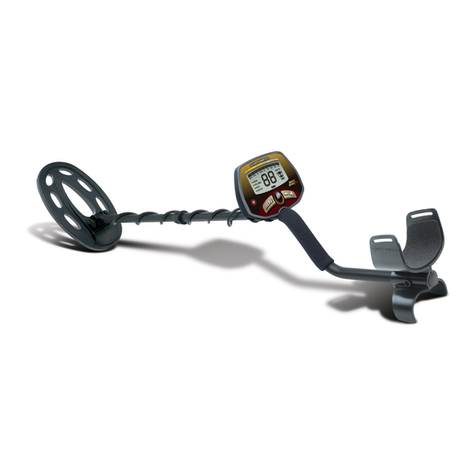
Bounty Hunter
Bounty Hunter Quick Draw owner's manual
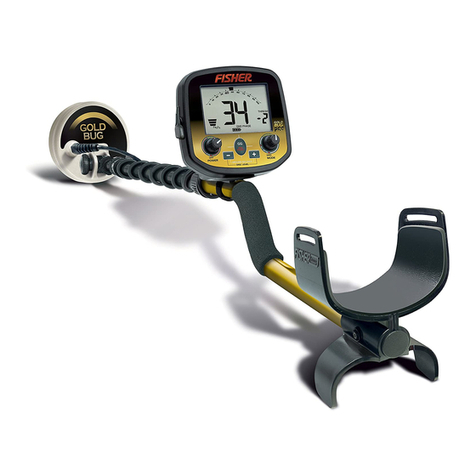
Fisher Research Labs
Fisher Research Labs Gold Bug Pro owner's manual
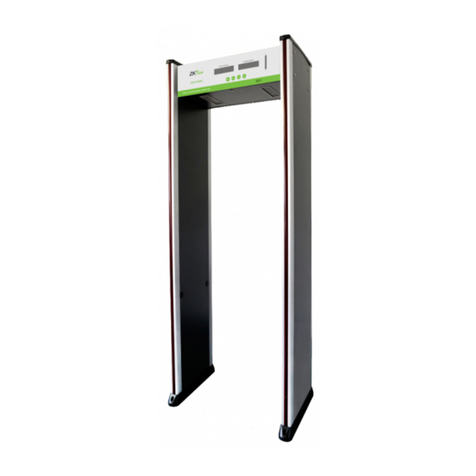
ZKTeco
ZKTeco ZK-D1065S user manual
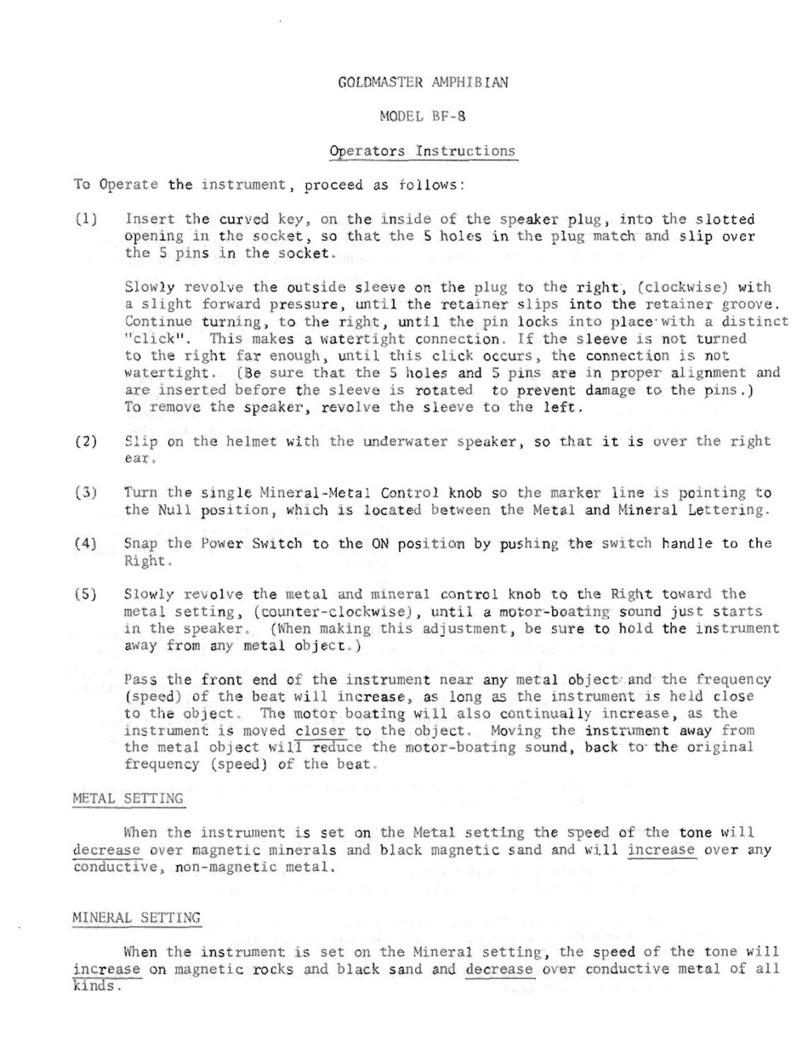
Goldmaster
Goldmaster BF-8 Operator instructions
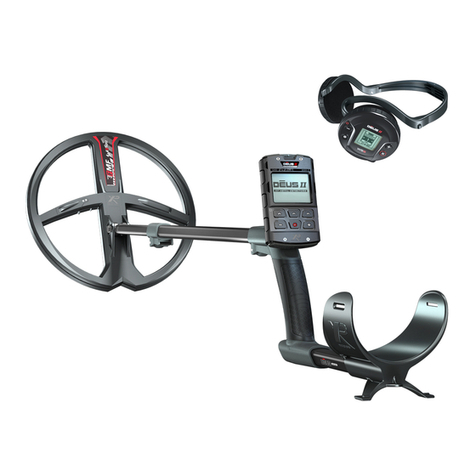
XP Metal Detectors
XP Metal Detectors DEUS II manual




